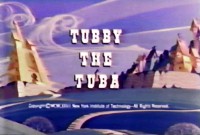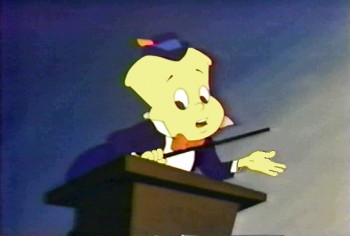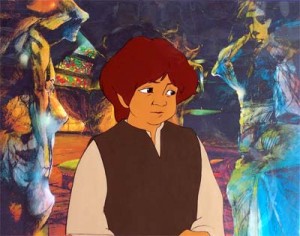Commentary 03 Nov 2009 08:40 am
Lmtd anim8n
 - There was a quiet day at the studio during the production of Tubby the Tuba. Johnny Gentilella and I were left alone for a few minutes during our lunch break. I took the opportunity to ask him a question I’d just about rehearsed asking for months prior.
- There was a quiet day at the studio during the production of Tubby the Tuba. Johnny Gentilella and I were left alone for a few minutes during our lunch break. I took the opportunity to ask him a question I’d just about rehearsed asking for months prior.
While working together previously on Letterman for the Hubleys, I was the person who assisted all of the  animators and inked all of the drawings. This was for 20 mins. of animation done in 2½ months in 1973. As a relative newcomer to the business, I studied and absorbed every drawing and exposure sheet that came my way. I was working with the work of some brilliant animators.
animators and inked all of the drawings. This was for 20 mins. of animation done in 2½ months in 1973. As a relative newcomer to the business, I studied and absorbed every drawing and exposure sheet that came my way. I was working with the work of some brilliant animators.
Essentially, in the kindest possible way, I asked Johnny Gent why a scene he did for Tubby at a podium matched a scene he did of Spellbinder, from  Letterman, at a podium almost drawing for drawing. The exact same scene with two different characters for two different films.
Letterman, at a podium almost drawing for drawing. The exact same scene with two different characters for two different films.
Johnny explained that in these days of low budgets and tight schedules the animator took the brunt of the responsibility for the movement despite the fact that there were no pencil tests to check on their scenes. If it didn’t work, the animator usually lost the job. So, said Johnny, he had to fall back on what he knew worked, use all the tricks at his disposal and make it acceptable to his client – the film’s director.
There wasn’t the opportunity for him to play around or experiment. He used what he knew. I understood his logic and said so.
I remember, a couple of months later, telling Tissa David this story. She responded that Johnny was so lucky to have such a memory. She wished she could remember what she’d done from day to day so that she could repeat it. But no. She had to come out drawing, experimenting and creating every scene from scratch.
While having coffee with John Dilworth last week we got into a conversation over something I’d posted on my blog. The subject started with the idea that humans do little motion in most of their activities.
 Ralph Bakshi . . . said that humans stand still most of the time, but that if an animated character would stay still, it wouldn’t be acceptable. It would look like poor limited animation. It’s a problem good animators enjoy solving.
Ralph Bakshi . . . said that humans stand still most of the time, but that if an animated character would stay still, it wouldn’t be acceptable. It would look like poor limited animation. It’s a problem good animators enjoy solving.
This led to our discussing what kind of animation is actually out there and how limited or generic or poor the movement. Then John said something that stopped my brain in its tracks. He said that there’s also the animator who doesn’t do the movement that he actually imagines for the character but limits it. The reasons are many: money, speed, laziness, whatever. The acting is bad because the client and/or public will accept the cheaper movement, so why do more.
I had to admit that this is probably true for 99% of all bad animation out there. Assuming the animator can do the movement properly, there’s the need to keep the money flowing, get the job in & out, or, in some cases, do all you need do to get the point across. It’s a cynical thought, but it’s probably also an accurate one for the reality of the world of the animator.
Animation’s come a long way since those days in 1973 when I worked at Tubby the Tuba. Now there are computers to “make our jobs easier.”
Programs like Flash not only encourage limited animation but demand it. As a matter of fact most computer-drawn imagery is more easily designed for limited animation. Though I’m writing and thinking, principally, about 2D – flat art, I expect some of the same problems exit for cg animation. Animated features done “traditionally” aren’t breaking much new ground either.
Now, I gaze at my navel wondering how much work I’m doing is in any way “daring”, and thinking that I have to start getting serious. I think we all do.

on 03 Nov 2009 at 8:52 am 1.John Schnall said …
Great post, Michael!
on 03 Nov 2009 at 9:43 am 2.Paul Spector said …
Geez, what a drag that you picked, arguably IMO, the worst moment in animation history to break into the biz. Thank G*d you had the guts to ask questions. All I remember from that period is a bunch of veterans grunting about the crappy work, and some up-and-comers wondering why they weren’t being taught anything.
on 03 Nov 2009 at 9:58 am 3.Kellie Strøm said …
Hasn’t the issue become even more slippery with digital animation? With digital inbetweening whether in 2D Flash or in 3D, it’s not a simple issue of absence of movement, but absence of informed, deliberate, movement. I find overuse of smooth digital inbetweening even more off-putting than the old kind of limited animation, where at least what I was seeing was a deliberate human choice.
(As I type I can imagine that somewhere a programmer has already come up with animation algorithms to introduce random jerkiness to digital inbetweening!)
on 03 Nov 2009 at 9:54 am 4.Michael said …
To the contrary, Paul. I worked on brilliant films right from the start.
After some editing work at Hal Seeger’s studio, I went to Hubley‘s studio where we did those Letterman pieces. A great work experience – very exciting and lots of fun. Then Tubby the Tuba moved me up the ranks to officially being called an Asst Animator, and I quit when I realized that I hated the experience. I loved Johnny Gent, but hated the environment of nastiness there. Then to work on the original Schoolhouse Rock films at Phil Kimmelman‘s PK&A and back to Hubley’s to work on Cockaboody and more Letterman. All in my first 9 months in the business. It was a magnificent time to break in as long as you saw the upside.
Older animators complained because they were no longer working on the tired and tedious shorts (meaning steady and boring employment) at Paramount or Terry’s.
on 03 Nov 2009 at 10:07 am 5.Michael said …
Boy, do I agree with you, Kellie. The computer drawings aren’t always up to par on those inbetweens, either. Not a human choice but an easy one (even though a human oversees the choice.)
on 03 Nov 2009 at 10:14 am 6.Dave Levy said …
I think that making the most of limited resources (time, money, etc) is an art form in itself, and a very underrated one at that. I’m not sure I agree that Flash demands limited animation. One can do full animation in the program or pure junk. These are the same possibilities that we used to have under an Oxberry camera. Flash just put the process at our fingertips: waiting for labs, no spending a whole evening bent over a camera, etc.
I’m not really a flash guy myself. Like, Michael, I prefer After Effects because it allows one to nearly fully recreate the Oxberry experience.
Paul Spector, I see your point, but I would argue that Michael picked the perfect time to enter the business (but really, as if any of us has a choice in that anyway?). Michael learned from giants. He gained the skills and confidence to go out on his own and has enjoyed a fantastic career as one of our most active and cherished independents. We each make our own “golden age.”
on 03 Nov 2009 at 10:15 am 7.Elliot Cowan said …
When you say “daring”, what kind of thing are you talking about?
Also.
I had the Danny Kaye record of Tubby the Tuba when I was a kid and was virtually obsessed with it ’till the age of 10.
on 03 Nov 2009 at 10:46 am 8.John R. Dilworth said …
Animation is a cosmological matter, like the Genesis story. We look at a static thing and in our mind give it all the motion it requires. The “tools” seduce to limit disobedience. They’re machines to generate immediate wonder; we become obedient to a more effective apple. As Woody Allen said, “We all have to choose our role models.”
on 03 Nov 2009 at 10:49 am 9.Richard O'Connor said …
I’m lost to what you mean by “movement”. By necessity animation requires refining of the human form. Like illustration, like Noh, every stitch and twitch of line has extraordinary weight.
I know you’re not advocating movement for movement’s sake. So I’m not sure what you are critiquing. Bad animation? Bad animation is not typically bad because it doesn’t have enough drawings -its bad because the drawings that are there are the wrong ones.
I would suggest that all of our favorite animators and directors (Fierlinger, Hubley, Miyazaki) succeed because their limitations force choices.
on 03 Nov 2009 at 11:06 am 10.Michael said …
Richard, my piece wasn’t so much about the drawings as it was about the “choices” bad choices. Choices for the sake of economics, speed or laziness.
John, You’re right, of course. Like an artist at a canvas or a block of marble, the animator has to deal with the technology to push it out of the way of the choices that will make it to the screen. “We become obedient to a more effective apple.”
Dave, I don’t want to look at the screen and think “Flash” because then I’m not looking at a character, I’m looking at the medium and not involved in the piece. The only Flash piece that I can think of that I didn’t think that was Nina Paley’s Sita Sings the Blues. It’s impossible to look at the E-surance ads without thinking Flash. I don’t want to see the computer just the character.
on 03 Nov 2009 at 11:12 am 11.R.Dress said …
Hey man I just wanted to thank you for the Frank Thomas animation of Mogli you pasted a while ago. I’ve been pouring over it for weeks now. (printed it out and matched up the peg holes to flip) Your a master animator too Michael. Thanks again for keeping up the Blog and sharing with us the tools and insight you’ve been gathering over the years on the job. Cheers!
on 03 Nov 2009 at 1:20 pm 12.Paul Spector said …
Hey Dave Levy, I agree with you and am now thinking about the differences between what was happening on the east coast vs the west in that time period: different types of opportunities in different types of studios for different animation people of all ages. Regardless, Michael was destined for larger things, as per the reason we get to write right now on the Splog.
Michael has previously commented several times about his disatisfaction with the NYIT Tubby the Tuba. If that ain’t six-degrees-of-separation enough, a few months ago I sent Michael a “Tubby the Tuba” model sheet that I have to I.D. — the input was that, yes, it was from the same production, and work was likely farmed out to my father in LA.
on 03 Nov 2009 at 1:45 pm 13.Michael said …
Your father does get credit as an animator. There are a number of excellent animators on the film; none of the work on screen shines brightly.
on 03 Nov 2009 at 5:23 pm 14.John Celestri said …
Michael, even though Tubby was my first long term gig in animation (and I’m grateful for having had the opportunity to learn a lot on-the-job)…the movie puts me to sleep after the first two minutes … However, if I hadn’t had that production experience on Tubby, I know you wouldn’t have hired me for Raggedy Ann & Andy.
… However, if I hadn’t had that production experience on Tubby, I know you wouldn’t have hired me for Raggedy Ann & Andy.
on 03 Nov 2009 at 6:24 pm 15.Dave Levy said …
Hi Michael,
On the flash issue, we have to respectfully disagree. I agree that things like the E-surance commercials have that flashy look. But, that’s not a flash thing, but how many animators use flash. In other words, what you are not digging is a puppeted type of animation in flash that relies on computer tweens. I don’t like that myself. But, we can all see how its an economic aid at times.
There are lots of examples of great animation done in flash. Take a student film by Meredith Gran from SVA a few years back. I was her advisor so I can attest that she drew and colored every frame in flash. Her backgrounds were traditional water color paintings. Here’s a link to her film: http://www.youtube.com/watch?v=9eO1aasHyTM
on 04 Nov 2009 at 5:35 am 16.slowtiger said …
The sad thing is that Flash is widely known, but ill-suited for the job of character animation. There is other software available for 2D vector animation with the ability of automatic tweening, but the results by far exceed the abilities of Flash.
Having done anything in 2D from traditional pen&paper to Flash and whatever, I say don’t blame the software, but only the artist’s choice of animation style.
on 04 Nov 2009 at 8:28 am 17.Willva said …
Hey mate
I agree that making money is the way to go, and being one of those offenders of extremly limited flash animation i can’t really talk, but i think the more time and money goes into a piece the more effective it will be in the end.
Now limited animation in flash is becoming quite common place, but an experienced animator can still utilize flash and make a great traditional animation but with a more digital twist.
Traditional animators shouldn’t do more limited animation, but should instead adapt themselves to the newer software thats out there such as flash or toonboom, and not lean on limited animation but utilize it as another tool in there arsenal. evolve i guess..
on 04 Nov 2009 at 11:51 am 18.Bob Jaques said …
I don’t use Flash and have no desire. Ex-employees of mine who animate in that program have told me about the bone crushing quotas imposed by the TV production companies. Given that – it’s no wonder that many animators operate by rote. Going with what they know is safe and will get the job done on schedule.
on 04 Nov 2009 at 1:21 pm 19.DanO said …
Flash is sold as an animation program that can reuse drawings and therefor save money during production. It can, and in treating drawings as paper dolls with rigid points of articulation, you have a steaming pile of refuse rather than real animation. But the attirbute that I think has led to Flash’s domination of 2D is the former point and not the latter – it has an angle that sells it; that it gets more done for less. 90% of the time it gets stuff done for less and its not more.
The marvel of Flash is that it can be used to make wonderfully effective animation. Jake Armstrong’s “The Terrible Thing From Alpha-9″ is the forst thing I think of.
http://www.cartoonbrew.com/brewtv/alpha9.html
Another good example would be Alex Butera’s “Baman Piderman” series which are the antithesis of the average Flash cartoon with their wild, weird, movement.
http://www.youtube.com/watch?v=2V5hkZsQiFE
I used to hate Flash with a rabid, mouth foaming, crusade of inflexibility and stubbornness. I saw the mean result of the animators working with it and rejected it as inferior. But I’ve since learned that this is the same old equation with different elements mixed in. Budgets dictate the amount of animation being done, and no one wants to spend the money to see the art form realized. The people with money will settle for less… and my own theory is that this keeps the truly gifted animators away because they never see anything that lures them to the program.
Even John Dilworth tried to coax me into learning Flash but I revolted in a flailing self righteous fit of impetuous indignation. I like to tell myself that all animators are susceptible to such behavior….
on 04 Nov 2009 at 2:08 pm 20.Michael said …
DanO
I have no doubt that Flash can be used for good animation and I said as much when talking about Nina Paley’s film.
I don’t really want to comment on the two pieces you mentioned, though I have seen Jake Armstrong’s “The Terrible Thing From Alpha-9″ a number of times already. (Many people recommend it as one of the better Flash films, and it is.)
However, even in Sita Sings the Blues, however much I like it, the animation is limited by the program.
on 04 Nov 2009 at 3:47 pm 21.Richard O'Connor said …
Obviously, Flash and the like have production benefits. Most of things that made film animation -and limited animation for film- a headache aren’t even considerations.
What the tool has difficulty with is allowing for sensitive character animation. Simulating human emotions through character drawings.
Nina Paley gets the emotional payoff in “Sita…” through her powerful storytelling and keen graphic sense -not through the performance within the animation.
The 2D digital process is still evolving. The production economies it offers are no different from the cut rate TV serials of the 70s and 80s. Let us hope it doesn’t remain at that low level of character performance.
on 04 Nov 2009 at 4:36 pm 22.DanO said …
I would say that “Sita Sings The Blues” has limited animation by design. Its a beautiful looking film. I love it. But, come on, you can’t judge a program by that film’s articulated, cut-out approach to animation.
Flash now has all of the tools necessary to do any kind of full animation. Besides those that i cited, Fran Kraus’s recent work is another great example.
on 05 Nov 2009 at 8:35 am 23.Céu D'Ellia said …
This kind of discussion always leads me to something that Oscar Grillo once said in a conversation: – It’s important to not think that making it move is the same as animating it.
on 06 Nov 2009 at 1:02 pm 24.George Griffin said …
As it this topic hasn’t been mulled over enough…
It used to be that the movies were always moving because a strip of film was going through a projector and actors who actually minimized their behavior (Chaplin, Keaton) often had the most impact. One consequence of and all digital animation (of which Flash is but a part) is that digital projection (it’s coming; it’s already here) is stone cold static, so anything “held” is the same as a slide show.
One aspect of character animation’s maturity is that the figures don’t have to telegraph their emotions with comic masks and broad actions. And this is due partly to the devolution of design: faces drawn with economic style (e.g. Blechman) can in the hands of Tissa David be so effective and affecting. The viewer must read and interpret the character. Then there’s Hertzfeldt.
And, it’s true, Flash lends itself, through “symbols,” to clusters of cycles which animators instantly detect, just as we used to be oh so bored with those eye blinks and mouth actions. But even if Flash were to be used to animate with fewer cycles, straight ahead, or even rotoscoping like Paley’s brilliant fire/dance sequence in Sita, would that make it a more artistic solution. Most animal actions are symmetrical, cyclic, because that leads to efficiency (limping is exhausting and actually leads to further injury). So, viewers tend to be startled into concentration by asymmetric, angular discontinuities.
To paraphrase Céu and Oscar, above, and I’ve heard the same from Breer, ” Ok, you’ve learned how to make it move, now what?
on 12 Nov 2009 at 11:07 pm 25.robcat2075 said …
Flash (or any of the other 2d CG tools) has never stopped anyone from drawing a better pose or drawing an needed inbetween. If those aren’t there in a Flash animation it’s because the animator chose not to do them or didn’t know he should have.
CG does get you instant feedback.
Remember that Gent guy you said had to rely on old work to get the job done because he couldn’t pencil test new ideas?
Get him on a Cintiq and he could have drawn his new idea right into Flash, and immediately tested it and toyed with the timing and everything. Excuses gone.
You can have as many great drawings in Flash as you want. But you gotta want them just like you did with the paper.
on 13 Nov 2009 at 11:00 am 26.John Celestri said …
I believe that Johnny Gent was the first animator Dr. Schure (sp?) assigned 33 years ago to try drawing with the computer tool Ed Catmull was developing for him at NY Tech. It was Johnny’s comments on the tool that focused attention on the problems that needed to be solved in order for the invention of the Cintiq to be possible decades later.
I remember Johnny telling me that the tool was like trying to draw with a blunt bar of soap.
on 13 Jun 2010 at 3:30 pm 27.n0kn0k said …
Kvalitetsposter som vanligt!